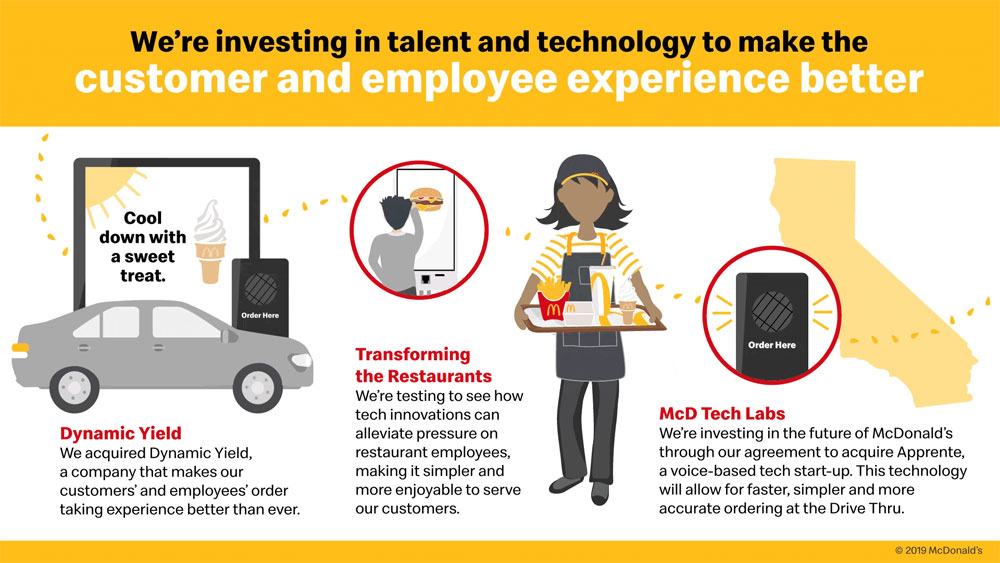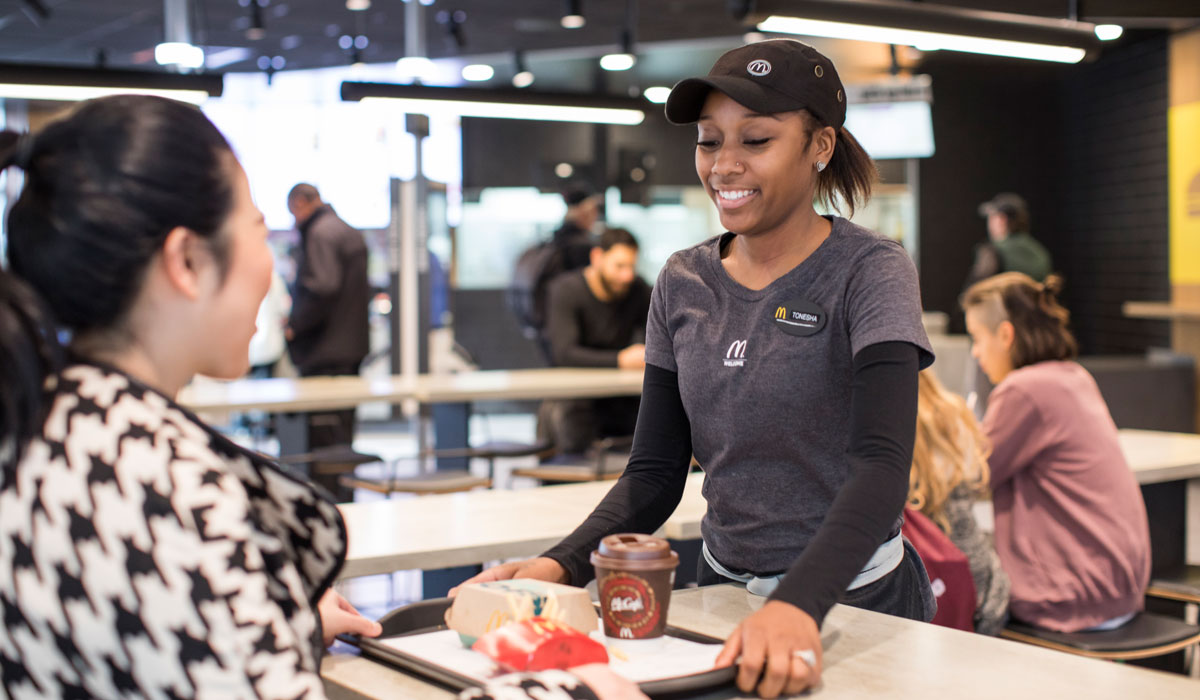It seems a long time ago that the notion of McDonald’s acquiring a company was improbable news. Before buying decision-logic leader Dynamic Yield for $300 million in late March, the fast-food chain hadn’t made a sizable purchase since scooping up Boston Market for $173.5 million. That was two decades ago. McDonald’s would later deal the chicken chain to Sun Capital Partners.
Chipotle also famously became a subsidiary of McDonald’s in 1999 when the company acquired controlling stake of the fast casual, at one point owning about 87 percent of the voting power of its common stock. The year? 2005. By October 2006, McDonald’s fully divested, having helped Chipotle grow from 14 locations to nearly 500 in a seven-year span.
And as interesting as the Dynamic Yield deal was on its own, it appears to have opened the tech floodgates for McDonald’s—a reality that will reverberate through quick service. On September 10, the company announced an agreement to acquire Apprente, an early stage leader in voice-based, conversational technology. McDonald’s didn’t disclose terms but investors have hinted it’s far less than the Dynamic Yield figure. The 2007-founded platform is expected to allow McDonald’s to provide faster, simple, and more accurate order taking at the drive thru, with the potential to later incorporate into mobile ordering and kiosks.
Additionally, the Apprente team became the founding members of a new, integrated, internal group within McDonald’s global technology team called McD Tech Labs. The brand said it expects to “grow its presence in Silicon Valley with the hiring of additional engineers, data scientists, and other advanced technology experts to join McD Tech Labs to meet future business needs and support deployment.”
If we’re talking near-term effect, both purchases lead directly to the drive thru. McDonald’s deployed Dynamic Yield to more than 8,000 U.S. restaurants in April and expects to onboard nearly all locations by year’s end. What it does, essentially, is create a more personalized customer experience by varying outdoor digital drive-thru menu displays to show food based on time of day, weather, current restaurant traffic, and trending menu items. And the decision tech also instantly suggests and displays more items to a customer’s order based on their current selections. In other terms: You order a Big Mac, McDonald’s suggests a drink and fries, and so forth. It’s an upselling tool that upsells itself without the need of employee assistance.

Couple that with Apprente’s voice-activated order taking functionality and McDonald’s drive-thru setup is suddely evolving at a blurring pace.
Before getting into why this is a significant turn, McDonald’s made more tech-related news Wednesday when it introduced what the company is calling “the world’s first voice-initiated applicate process,” the McDonald’s Apply Thru.
People can now start a McDonald’s job application by saying, “Alexa, help me get a job at McDonald’s,” to their device. It works on Google Assistant, too, with the command, “OK Google, talk to McDonald’s Apply Thru.”
As this evolves, McDonald’s said prospective employees will be able to simply ask, “OK Google, help me get a job at McDonald’s.”
The voice experience is currently available in the U.S., Australia, Canada, France, Germany, Ireland, Italy, Spain, and the U.K. More are expected in the coming months.
After opening McDonald’s Apply Thru, users jump-start the application process by answering a few basis questions ranging from their name, job area of interest, and location. Potential applicants then receive a short text message with a link to continue.
“We must continue to innovate and think of creative, and in this case, groundbreaking ways to meet potential job seekers on devices they are already using, like Alexa,” said McDonald’s executive vice president and chief people officer David Fairhurst in a statement.

More on the big picture
If there’s one thing you can say about McDonald’s tech strategy it’s that it’s aggressive. And maybe it needed to be. Focusing on just the drive thru, McDonald’s headed into 2019 seeing its speed of service increase, year-on-year, for five straight. This past year, it was last in QSR’s Drive-Thru study with a time of 273.29 seconds. In 2017, the brand clocked 188.83 seconds. It slowed to 189.49 the following year and has trended in that direction ever since.
While McDonald’s same-store sales have been healthy in recent quarters (Q2’s U.S comps of 5.7 percent were the highest since the launch of All-Day Breakfast in Q4 2015), much of the growth has come from check, not from traffic. Domestically, Q2’s figure was comprised of roughly two-thirds product mix and a third via price. CFO Kevin Ozan said McDonald’s wasn’t losing guests necessarily. Rather, it was dropping customer visits. Or put simply, guests are not visiting McDonald’s as often as they were historically. They are spending more, however.
BTIG analyst Peter Saleh wrote in note this week that McDonald’s transaction growth has suffered in recent years “partly due to slower speed of service.”
This isn’t restricted to drive thrus. It’s deteriorated systemwide thanks to higher labor turnover and increased menu complexity from All-Day Breakfast, Signature Crafted items (since removed), and fresh beef. Those slowdowns just flash brighter in the drive thru when cars are snaking around the building and the issue is on full display.
Here’s another point: Only two of the 10 restaurant brands studied in 2018’s Drive-Thru Study reported having six or more vehicles more than 2.4 percent of the time. One was Chick-fil-A (38.9 percent). The other was McDonald’s (11.9 percent). That could signal a positive argument—that McDonald’s and Chick-fil-A are really busy. But it also suggests there’s plenty of profit to be gained by getting those cars through quicker.
For three to five vehicles in line, Chick-fil-A came in at 33 percent. McDonald’s was higher at 40.5 percent.
It’s pretty crystal why McDonald’s CEO Steve Easterbrook said in May that he was personally taking the lead on improving the company’s drive-thru experience.
Dynamic Yield deserves all the upselling credit it deserves, yet there’s a spend element at play as well. The platform uses data collected based on current restaurant traffic and then starts suggesting items that make peak times easier on restaurant operations and crews. McDonald’s has implemented other changes, like drive-thru competitions, and worked to cut complexity out (removing Signature Crafted, simplifying late-night lineups, and offering operators more flexibility with All-Day Breakfast).
Only two of the 10 restaurant brands studied in QSR’s 2018’s Drive-Thru Study reported having six or more vehicles more than 2.4 percent of the time. One was Chick-fil-A (38.9 percent). The other was McDonald’s (11.9 percent).
Easterbrook said the competitive speed challenge, which pits regions of the country against each other, with incentives funded by the company, helped boost service times 15 seconds in June. By year-end, McDonald’s expects the run-rate improvement in service times to be about 30 seconds, or roughly half of what it lost over the last three years.
Apprente should aid in time, too.
Saleh said the platform will eventually “largely automate the ordering process, reducing labor hours and, more importantly, increasing throughput by speeding up the ordering process. We believe there could also be some operational and financial benefits to using this technology for managerial tasks like inventory management.”
It will ultimately split employees’ duties of order taking and accepting payment, thus boosting speed given drive-thru bottlenecks typically occur at the point of ordering. That duty will be taken off employees’ plates and result in “materially faster throughput,” Saleh said.
The big headline to chase: solving throughput to unlock transaction growth. And McDonald’s is just scratching the surface of this opportunity.

Tech raises the bar
Saleh upped his price target on McDonald’s stock to $240 from $220 “given its more aggressive technology strategy and resulting sales benefit,” he wrote.
Saleh believes McDonald’s investments will widen the competitive gap, improve sales and throughput, and eventually capture critical customer data.
On the Dynamic Yield deal in particular, he said, McDonald’s could generate 130–200 basis points of incremental menu mix as consumers add more fries, drinks, and McNuggets to orders. The benefit should start showing in Q3 of this year and build into fiscal 2020 as the tech hits all drive thrus.
BTIG estimated the average price of a medium French fries, drink, and Chicken McNuggets at $1.43. So, if the Dynamic Yield technology successful upsells 10–15 percent of consumer transactions in the drive thru, where two-thirds of McDonald’s sales come from, we’re looking at a serious figure.
“We believe this estimate is realistic as McDonald’s wouldn’t make such an investment if it impacted less than 10 percent of their customers, nor would they deploy it so rapidly across the system if the benefit wasn’t impactful,” Saleh wrote.
It’s worth remembering that McDonald’s intends to use the tech across all of its digital ordering platforms in time (kiosks and mobile app). That will help, but not quite at the level of drive thru.
Here’s a potential look at what it could do to average check for McDonalds (based on BTIG estimates and company documents).
McDonald’s vitals:
- Average-unit volume: $2.76M
- Drive-thru mix: 67 percent
- Average check: $6.25
- Drive-thru transactions: 295,872
Upsell proportion:
Transactions
- 5 percent: 14,794
- 10 percent: 29,587
- 15 percent: 44,381
- 20 percent: 59,174
- 25 percent: 73,968
Check increase
- 15 percent: $1.43 added
Additional sales
- 5 percent: $21,155
- 10 percent: $42,230
- 15 percent: $63,465
- 20 percent: $84,619
- 25 percent: $105,774
Comp benefit
- 5 percent: 0.8 percent
- 10 percent: 1.5 percent
- 15 percent: 2.3 percent
- 20 percent: 3.1 percent
- 25 percent: 3.8 percent
System comp benefit
- 5 percent: 0.7 percent
- 10 percent: 1.3 percent
- 15 percent: 2 percent
- 20 percent: 2.6 percent
- 25 percent: 3.3 percent
Note: the system comp benefit reflects inclusion of 2,000 U.S. store without drive thru.

What’s next?
Is McDonald’s done buying tech companies and platforms? Unlikely. After working on service times and drive thru, Saleh said, McDonald’s should turn its efforts to streamlining the ordering process. Domino’s is a good example, with its pizza profiles that enable easy reordering.
“We believe that quick-service customers are very habitual, ordering the same items most of the time,” he said. Chipotle previously noted that customers order the same item 80 percent of the time, albeit a smaller menu.
That opens a unique window of chance for quick-serves, Saleh noted. The ability to suggest a specific meal based on customer history, rather than waiting for the guest to order, is something that has real potential to boost service times and throughput since diners could just confirm, reject, or change. They don’t have to start from zero every time.
But McDonald’s does have some work to do to get there. The chain would need to be able to uniquely identify each customer in the drive thru in advance of payment, Saleh said.
A way forward: through a loyalty program, mobile app beacons, license plate recognition or some other way to identify vehicles.
Saleh pointed out 5thru, a company whose Drive-Thru Accelerator solution launched last October, as one such provider. The company said it allowed some restaurants to process 30 extra cars per day. In McDonald’s case, at $6.25 average check, that would amount to 250 basis points of incremental same-store sales (210 basis points for the entire U.S. system) if each restaurant saw 30 additional cars, per day. It goes back to the cars in line statistic and how much runway exists.
Toss in the capability of linking a saved payment method to customers’ license plates, as some solutions allow, and the conversation ticks up another notch. “Offsetting some of this potential sales benefit would likely be some form of discounts or customers perks, potentially from a loyalty program, to incentivize consumers to opt in and link their vehicle information to their credit card and customer profile,” Saleh wrote.
There’s little question it would be worth it, however.








